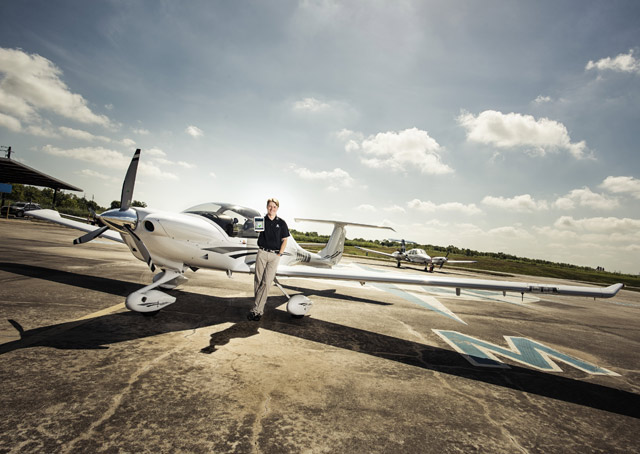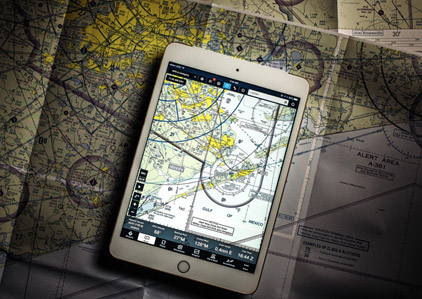
 It’s the end of a long day at Sun ’n Fun and Tyson Weihs is geeking out about market growth, user experience, and databases. His team’s strategy is buried in these fundamental elements of the business, and they combine to form a surprisingly organized execution for what is clearly a sprint of marathon length. It’s one of the reasons ForeFlight remains aviation’s iPad application leader.
It’s the end of a long day at Sun ’n Fun and Tyson Weihs is geeking out about market growth, user experience, and databases. His team’s strategy is buried in these fundamental elements of the business, and they combine to form a surprisingly organized execution for what is clearly a sprint of marathon length. It’s one of the reasons ForeFlight remains aviation’s iPad application leader.
Weihs is a co-founder of ForeFlight and very much its public face. Finding those can be difficult at companies dominated by programmers who thrive on coding and its unrelenting pace, and who consider press conferences and partner meetings to be torture. Weihs is unique because he has the coding chops and he’s not afraid to stand up in front of people and push his product and his vision. He’s known to other players in the industry as a tough, passionate advocate for his business, seemingly at ease switching between beast mode and that of happy salesman.
We’re at a Bonefish Grill, which turns out to be handy. It’s one of those restaurants with white butcher paper over the table and Weihs is using it to his advantage. He borrows my pencil to sketch out sales charts, explain the difficulties of managing multiple offices, and describe how international nav data has the potential to expand the business. Our dinner has turned in- to a shareholder meeting.
Astronomical growth
 Apple doesn’t release market data, so it’s virtually impossible to quantify any one company’s share of the aviation app business. ForeFlight does it with user surveys, Seattle Avionics says it has some licensing information, while others simply have to focus on their own returns. What is clear is that ForeFlight is the undisputed king of this empire. Get a roomful of pilots together and ask for a show of hands of who uses what app, and ForeFlight invariably wins—by a lot.
Apple doesn’t release market data, so it’s virtually impossible to quantify any one company’s share of the aviation app business. ForeFlight does it with user surveys, Seattle Avionics says it has some licensing information, while others simply have to focus on their own returns. What is clear is that ForeFlight is the undisputed king of this empire. Get a roomful of pilots together and ask for a show of hands of who uses what app, and ForeFlight invariably wins—by a lot.
Weihs says he estimates they have seven of 10 aviation customers. To put that into perspective, that leaves roughly 10 other apps to divide the remaining 30 percent of the pie. Which, of course, isn’t to say that ForeFlight is the best app. The question is too subjective. Do you like Coke or Pepsi? Both are cold shots of sugar. What you drink likely has more to do with what you started drinking 20 years ago, and where you grew up, rather than the quality or list of ingredients on the can. iPad apps are no different. They all cost about the same, and it’s a conservative estimate to say they share 90 percent of the same features. The differences are in how those features are presented, or in programmer lingo the UX (for user experience).
Succeeding in a business like that seems as if it could have more to do with marketing and chance than quality. But in ForeFlight’s case, luck had nothing to do with it. Two key factors have influenced its success—they were out of the gate early, and they have kept up a dizzying pace of innovation. “First is important but first is fleeting,” Weihs says. “It gets you off the launch pad but not in to orbit.”
Innovation is a key of the company’s business model. Given that every update is a free piece of marketing, and users of Apple products have come to expect excellent features and a good user experience, it is critical that an app developer continue to push updates. “My mentality is that someone is coming to eat you,” he says. “With a sword hanging over you, you run as fast as you can.”
In the beginning the upgrade process was based on nothing more than customer feedback and what the partners wanted. Lots of “wouldn’t that be cool” sort of conversations among the small team, in other words. As the user base grew it became clear that a more formalized system had to be in place to objectively handle the seemingly endless stream of ideas and requests.
A key hire brought the concept of strategic planning, resulting in the current upgrade methodology. It goes like this: Every idea, whether from a user or staff, gets thrown into a rating system. It’s graded on factors such as development time, expectation of attracting new customers, whether it’s a fix or improvement, and so on. They even weigh each upgrade’s impact on maintaining the proper ratio of customer growth to retention. Periodically the leadership team determines the amount of developer time available, adds up the scores on the ideas, and determines which are worthy of investment. Their goal is to release an update with new features and fixes every six to eight weeks. “Every dollar you put in design yields 10 in return,” Weihs says.
Just in the past year the company has added features such as an instrument approach preview advisor, three-dimensional track history, weight and balance, and synthetic vision. The latest build saw the release of an entirely new product—a web version for existing mobile customers.
The past
How ForeFlight got to this point is largely a reflection of the people who built it. Weihs says he, like co-founder Jason Miller, comes from a family of creatives. His father was an entrepreneurial chef, so the desire to create new things was ever-present at home. He’s a programmer and business executive by trade, having started his own ecommerce company while still in college. He went to work for SMH Private Equity Group, where he says he learned to close a deal. It’s a skill that’s proven to be vital to ForeFlight’s success. Some acquisitions and partnerships have positioned the company well over the past few years, most notably the relationship with Sporty’s Pilot Shop and Appareo Systems involving the Stratus. The device has become synonymous with portable ADS-B In and given ForeFlight a group of highly loyal customers.
Weihs, Miller, and partner Adam Houghton launched the company in 2007, roughly the same time Apple’s first iPhone became available. It began as a hobby business and was very much the image of programmers in their basements at wee hours hunched over a computer.
In fact, Weihs didn’t quit his day job until 2011.
In 2008 the first version of ForeFlight Mobile was launched. There wasn’t much of a plan, other than to have fun and keep the software going. When the iPad came out he says they didn’t even know if they would transition the program over to it. The tablet seemed large and the need questionable. Then, he says, they saw an approach plate load and knew it was going to be big.
In the past two years they’ve gone from eight employees to 60, purchasing a few companies along the way. They now serve 1,000 corporate flight departments, and half of the military. NASA is a customer, as are Southwest and Frontier Airlines. With three-quarters of the GA market and hundreds of corporate clients, it’s hard to imagine there’s anywhere to go but flat. Some users of other apps may switch, and others may finally give in and buy an Apple device. But one thing’s for sure, not a lot of new people are learning to fly—and Android seems out of the question. Weihs has said the return doesn’t justify the investment. Apple rules the aviation tablet business.
Weihs says he isn’t terribly worried about sustaining their impressive year-over-year growth. For one, they aren’t that penetrated into business aviation, and two, it’s a big world out there—much of it without ForeFlight. Not satisfied with dominating the national market, it seems like world domination might be next.
Having exceeded their sales targets again and again, it would be foolish to bet against Weihs’ seemingly lofty goal of making ForeFlight a $500 million company within three years. Do they sell at that point and retire to the Caribbean? He smiles. “I don’t know,” he says. “But I hope to find out.”
Email [email protected]
Photography by Tom Hussey
Goliath versus Goliath
When Garmin released its Pilot app it seemed like David versus Goliath, an epic struggle of small firm versus the mighty Garmin. Turns out things were more Goliath versus Goliath, as ForeFlight transitioned from upstart to major player in the avionics world. That was more evident than ever this year, when after years of holding out, Garmin announced it would open its doors to ForeFlight and others, and allow them to play with the company’s various panel-mounted avionics. It was a clear signal of ForeFlight’s rise, and a changing shift in the avionics landscape.



